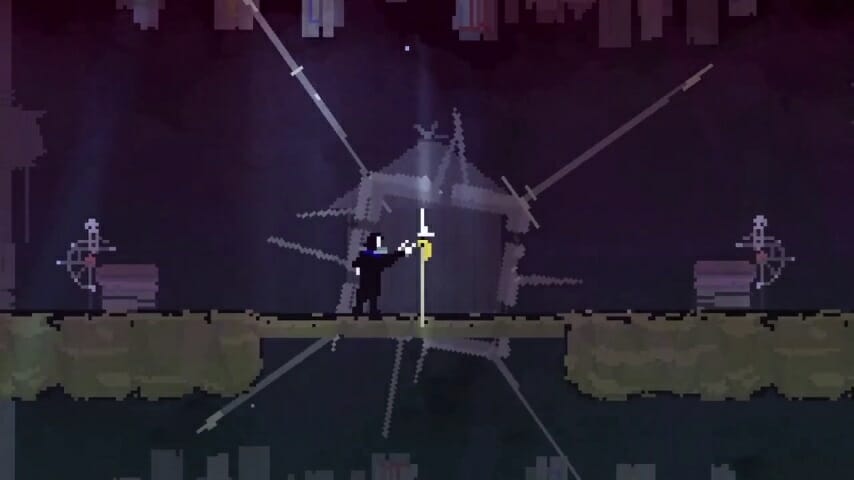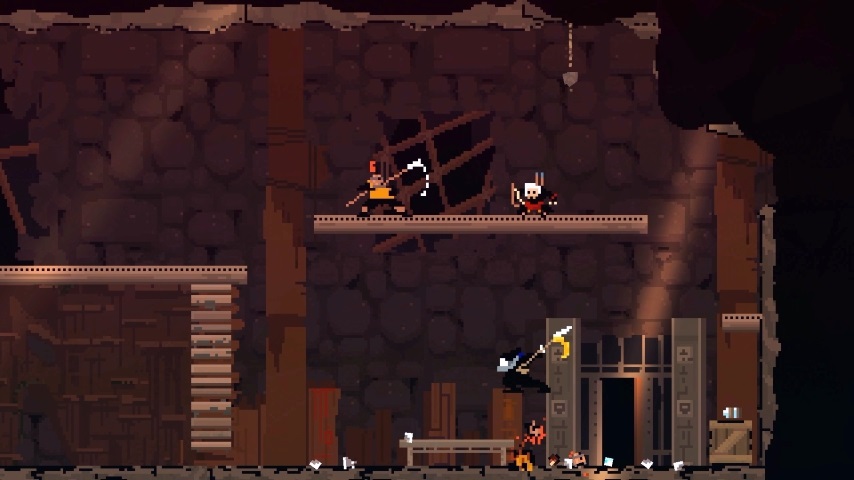Olija Uses Its Retro Aesthetic to Create a Sense of Desolation

Nostalgia is a constant in games, much as it is in all pop culture these days. Despite the rich history of videogames, though, retro-minded games tend to stick to a few basic reference points. We’ve seen lots of 8-bit and 16-bit homages, a steady stream of ‘90s JRPG riffs and sidescrolling platformers, and lately a surge in interest in the early polygonal days of the mid ‘90s. When you hear of some new independent game that intentionally evokes the past, you’ll likely assume it’s one of those concepts getting another once-over.
Visually Olija owes a great deal to a certain type of game from the ‘80s, but not one that gets exhumed that often anymore. Although it is fundamentally another sidescrolling platformer—there are platforms, you walk and jump between them while moving to either side—it pays respects to an art style that once defined computer games but isn’t as ubiquitous in the retro scene as 8- or 16-bit pastiche. This stately, mysterious adventure tips its (many) hats squarely in the direction of Sierra On-Line, the pioneering studio behind series like King’s Quest, Space Quest, and Quest for Glory. Olija captures the look of mid ‘80s Sierra games in all their blocky EGA glory, only with a darker, apocalyptic aesthetic that infuses the game with a palpable sense of sorrow. Like many games, Olija tasks you with exploring a fallen civilization, only it uses a visual language that reinforces an overriding atmosphere of desolation and abandonment.
This art design is crucial to Olija’s success, as the game itself doesn’t do that much to stand out from the last decade or so of sidescrollers enamored with the past. It doesn’t resemble any specific game too closely, and has a couple of somewhat unique wrinkles that we’ll discuss below, but Olija is less interested in the (frequently obtuse) problem-solving of the adventure games it looks like, and more focused on bursts of hacking and slashing while looking for the right key or lever that’ll open the next locked door. It’s not as strictly linear as many similar games; your protagonist, Faraday, can usually sail to two or three different islands at a time, each one representing a distinct level. And they can usually be returned to at any time, in any order, if needed. But the game’s take on classic sidescrolling action isn’t as inspired or as accomplished as its visual acumen.

Two mechanics provide a bit of spice to the relatively flavorless combat. One of your main weapons is a magical harpoon that you can instantly teleport to after throwing. You’ll use this not just to zip through enemies, but also as a variation on a grappling hook; throughout the game you’ll have to fling that harpoon at these weird alien-looking nodules that you can use to get to places you can’t otherwise reach. Eventually you’ll have to string several of these moves in a row to get across wide chasms or beds of spikes, with only a small sliver of time to react between each throw before falling into the abyss. It’s a slightly more interesting and interactive take on the typical grappling beam.
Olija also recognizes the value of a snazzy hat. There’s a small selection of unlockable hats you can earn throughout the game, and they all give you a different helpful skill. One hat is adorned with a jaunty red feather that can split into four and slice through your enemies at the end of a combo. Another restores a tiny bit of health as you kill enemies. A third makes you more resistant towards acid. None of the hats are game changers, but they add a little extra bit of strategy, while also giving you a reason to collect the resources needed to create them. Your home island has a hat maker, making Faraday perhaps the only game character with his own personal haberdasher.
Although Olija is mechanically sound, it doesn’t always inspire that compulsion to keep pushing forward. There are some games you don’t want to ever put down, and some you have to force yourself through if your job is writing about games. Olija is solidly in the middle: a perfectly fine and enjoyable piece of work, but not something that calls to me when I’m otherwise occupied.
It all comes down to the aesthetic—the muted color palette, the hushed tones when characters speak, the overarching sense of loss and despair that permeates the game. And most notably, those archaic visuals that look like they’re from the latest Sierra game you and your friend play on his Tandy computer every afternoon after school. Olija roots its mysteries in the ever-distant, increasingly forgotten past, with all the warmth and sadness that implies.
Olija was developed by Skeleton Crew Studio and published by Devolver Digital. Our review is based on the Switch version. It is also available for PC, PlayStation 4, and Xbox One.
Senior editor Garrett Martin writes about videogames, comedy, music, travel, theme parks, wrestling, and anything else that gets in his way. He’s on Twitter @grmartin.